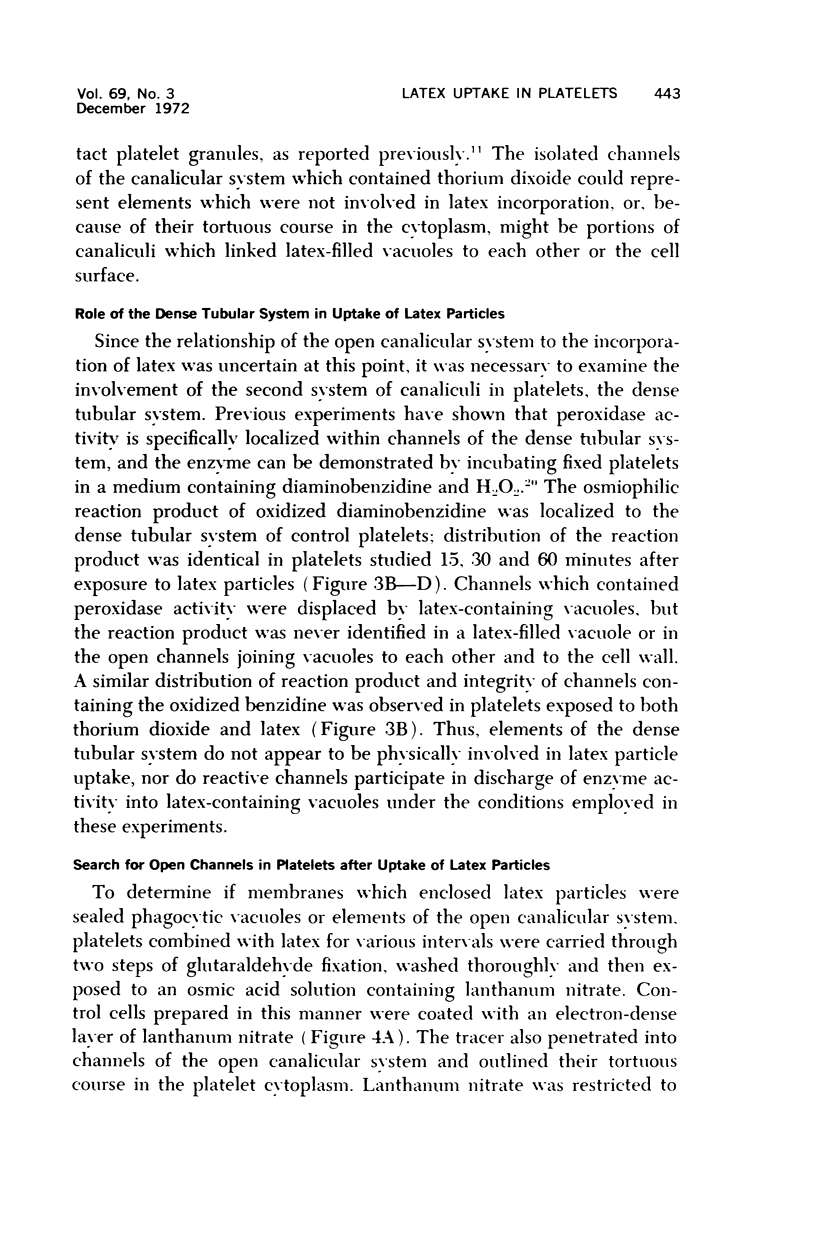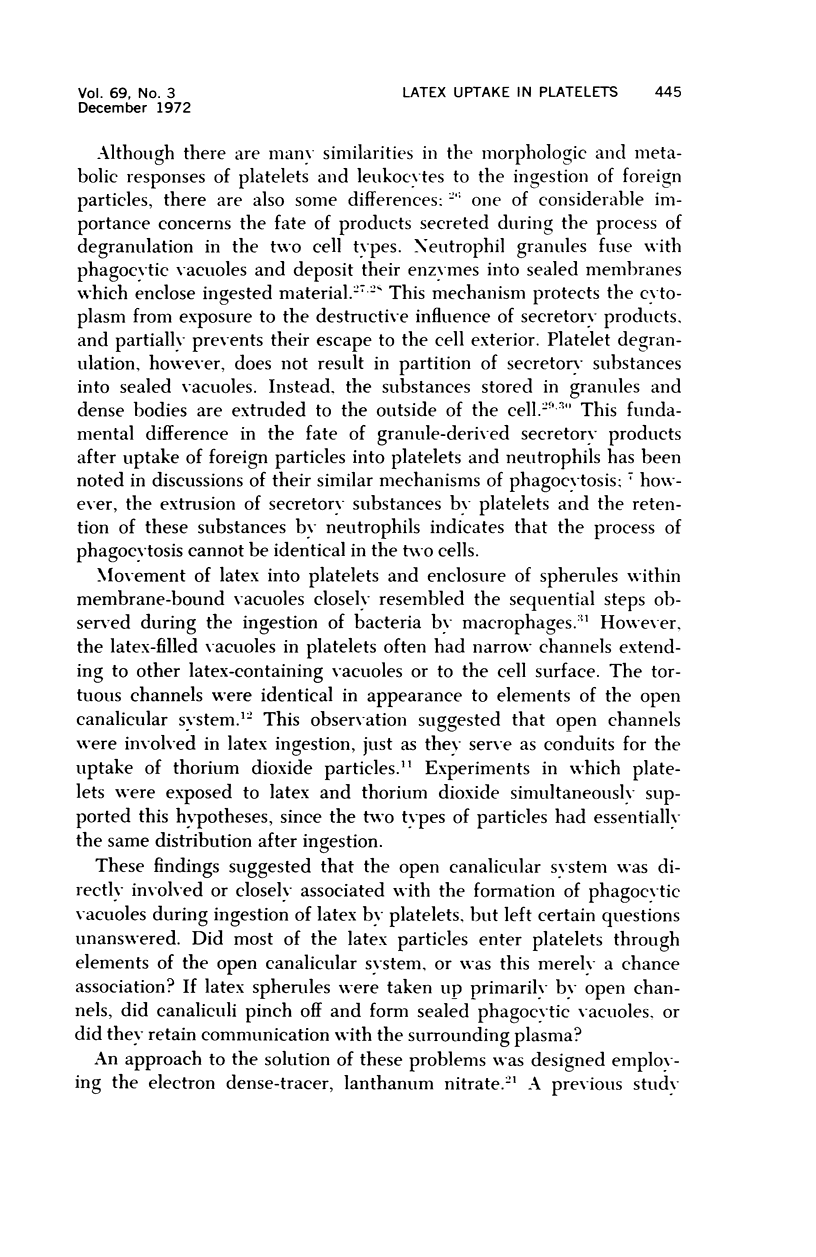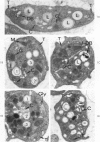Abstract
The incorporation of large particulates by blood platelets is considered identical to the ingestion of bacteria by neutrophils, and is referred to as platelet phagocytosis. However, bacteria enter neutrophils in sealed vacuoles derived from the cell wall, and products deposited in the vacuoles during neutrophil degranulation are confined almost exclusively to the phagolysosomes. Products released from platelet storage organelles after uptake of foreign particles, on the other hand, are extruded to the cell exterior. The basis for this unusual difference in the phagocytic response of platelets and neutrophils has been sought in the present investigation. Combined electron microscopic and cytechemical study of platelet-latexspherule interaction revealed that platelets do not phagocytize in the usual sense. Most of the latex particles observed in platelets were lodged in channels of the open canalicular system. Channels which contained latex did not pinch off to form sealed phagocytic vacuoles, but remained open. An electron-dense tracer, lanthanum nitrate, was able to penetrate into the channels and outline the ingested latex particles. Therefore, platelets do not phagocytize latex, but sequester the spherules in preformed membranous invaginations. The persistence of open channel communication with the exterior after latex uptake may explain why platelets extrude secretory products, rather than confine them to phagolysosomes.
Full text
PDF



















Images in this article
Selected References
These references are in PubMed. This may not be the complete list of references from this article.
- BLOOM G. The disintegration of human blood platelets after taking up fine quartz particles. Z Zellforsch Mikrosk Anat. 1954;40(3):222–227. doi: 10.1007/BF00347926. [DOI] [PubMed] [Google Scholar]
- Behnke O. Electron microscopic observations on the membrane systems of the rat blood platelet. Anat Rec. 1967 Jun;158(2):121–137. doi: 10.1002/ar.1091580203. [DOI] [PubMed] [Google Scholar]
- Clawson C. C., White J. G. Platelet interaction with bacteria. I. Reaction phases and effects of inhibitors. Am J Pathol. 1971 Nov;65(2):367–380. [PMC free article] [PubMed] [Google Scholar]
- Cohn Z. A. The structure and function of monocytes and macrophages. Adv Immunol. 1968;9:163–214. doi: 10.1016/s0065-2776(08)60443-5. [DOI] [PubMed] [Google Scholar]
- David-Ferreira J. F. The blood platelet: electron microscopic studies. Int Rev Cytol. 1964;17:99–148. doi: 10.1016/s0074-7696(08)60406-4. [DOI] [PubMed] [Google Scholar]
- Davis A. T., Estensen R., Quie P. G. Cytochalasin B. 3. Inhibition of human polymorphonuclear leukocyte phagocytosis. Proc Soc Exp Biol Med. 1971 May;137(1):161–164. doi: 10.3181/00379727-137-35535. [DOI] [PubMed] [Google Scholar]
- Dejesus M., Jr, Fikrig S., Detwiler T. Phagocytosis-stimulated nitroblue tetrazolium reduction by platelets. J Lab Clin Med. 1972 Jul;80(1):117–124. [PubMed] [Google Scholar]
- GLYNN M. F., MOVAT H. Z., MURPHY E. A., MUSTARD J. F. STUDY OF PLATELET ADHESIVENESS AND AGGREGATION, WITH LATEX PARTICLES. J Lab Clin Med. 1965 Feb;65:179–201. [PubMed] [Google Scholar]
- Gröttum K. A., Hovig T., Holmsen H., Abrahamsen A. F., Jeremic M., Seip M. Wiskott-Aldrich syndrome: qualitative platelet defects and short platelet survival. Br J Haematol. 1969 Oct;17(4):373–388. doi: 10.1111/j.1365-2141.1969.tb01383.x. [DOI] [PubMed] [Google Scholar]
- O'Brien J. R. Platelet stickiness. Annu Rev Med. 1966;17:275–290. doi: 10.1146/annurev.me.17.020166.001423. [DOI] [PubMed] [Google Scholar]
- Quie P. G., White J. G., Holmes B., Good R. A. In vitro bactericidal capacity of human polymorphonuclear leukocytes: diminished activity in chronic granulomatous disease of childhood. J Clin Invest. 1967 Apr;46(4):668–679. doi: 10.1172/JCI105568. [DOI] [PMC free article] [PubMed] [Google Scholar]
- Revel J. P., Karnovsky M. J. Hexagonal array of subunits in intercellular junctions of the mouse heart and liver. J Cell Biol. 1967 Jun;33(3):C7–C12. doi: 10.1083/jcb.33.3.c7. [DOI] [PMC free article] [PubMed] [Google Scholar]
- Shea S. M. Lanthanum staining of the surface coat of cells. Its enhancement by the use of fixatives containing Alcian blue or cetylpyridinium chloride. J Cell Biol. 1971 Dec;51(3):611–620. doi: 10.1083/jcb.51.3.611. [DOI] [PMC free article] [PubMed] [Google Scholar]
- Stossel T. P., Pollard T. D., Mason R. J., Vaughan M. Isolation and properties of phagocytic vesicles from polymorphonuclear leukocytes. J Clin Invest. 1971 Aug;50(8):1745–1747. doi: 10.1172/JCI106664. [DOI] [PMC free article] [PubMed] [Google Scholar]
- Weissmann G., Dukor P., Zurier R. B. Effect of cyclic AMP on release of lysosomal enzymes from phagocytes. Nat New Biol. 1971 Jun 2;231(22):131–135. doi: 10.1038/newbio231131a0. [DOI] [PubMed] [Google Scholar]
- White J. G., Estensen R. D. Degranulation of discoid platelets. Am J Pathol. 1972 Aug;68(2):289–302. [PMC free article] [PubMed] [Google Scholar]
- White J. G. Fine structural alterations induced in platelets by adenosine diphosphate. Blood. 1968 May;31(5):604–622. [PubMed] [Google Scholar]
- White J. G. The transfer of thorium particles from plasma to platelets and platelet granules. Am J Pathol. 1968 Oct;53(4):567–575. [PMC free article] [PubMed] [Google Scholar]
- Wolfe S. M., Shulman N. R. Inhibition of platelet energy production and release reaction by PGE1, theophylline and cAMP. Biochem Biophys Res Commun. 1970 Oct 9;41(1):128–134. doi: 10.1016/0006-291x(70)90478-x. [DOI] [PubMed] [Google Scholar]
- ZUCKER-FRANKLIN D., HIRSCH J. G. ELECTRON MICROSCOPE STUDIES ON THE DEGRANULATION OF RABBIT PERITONEAL LEUKOCYTES DURING PHAGOCYTOSIS. J Exp Med. 1964 Oct 1;120:569–576. doi: 10.1084/jem.120.4.569. [DOI] [PMC free article] [PubMed] [Google Scholar]








